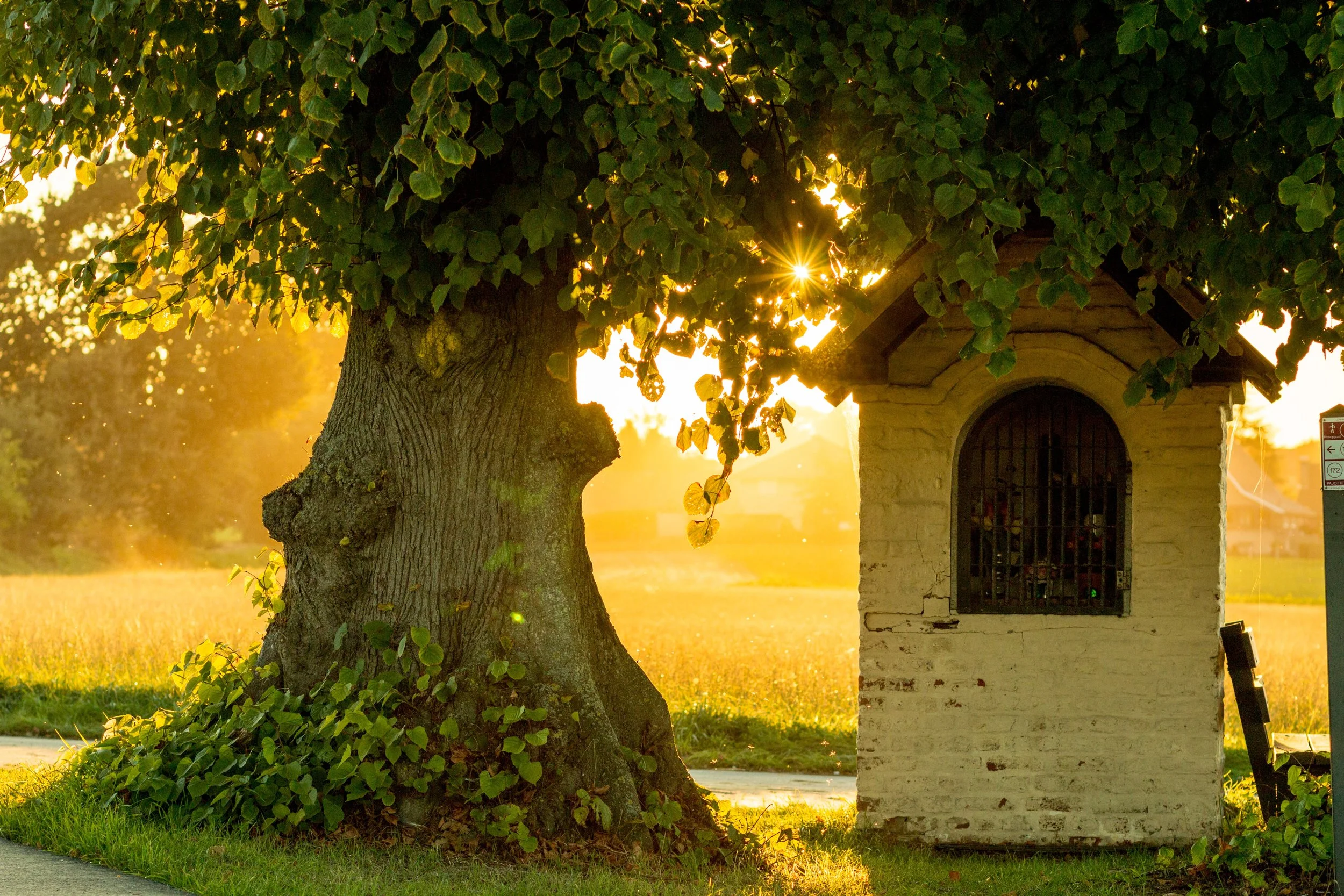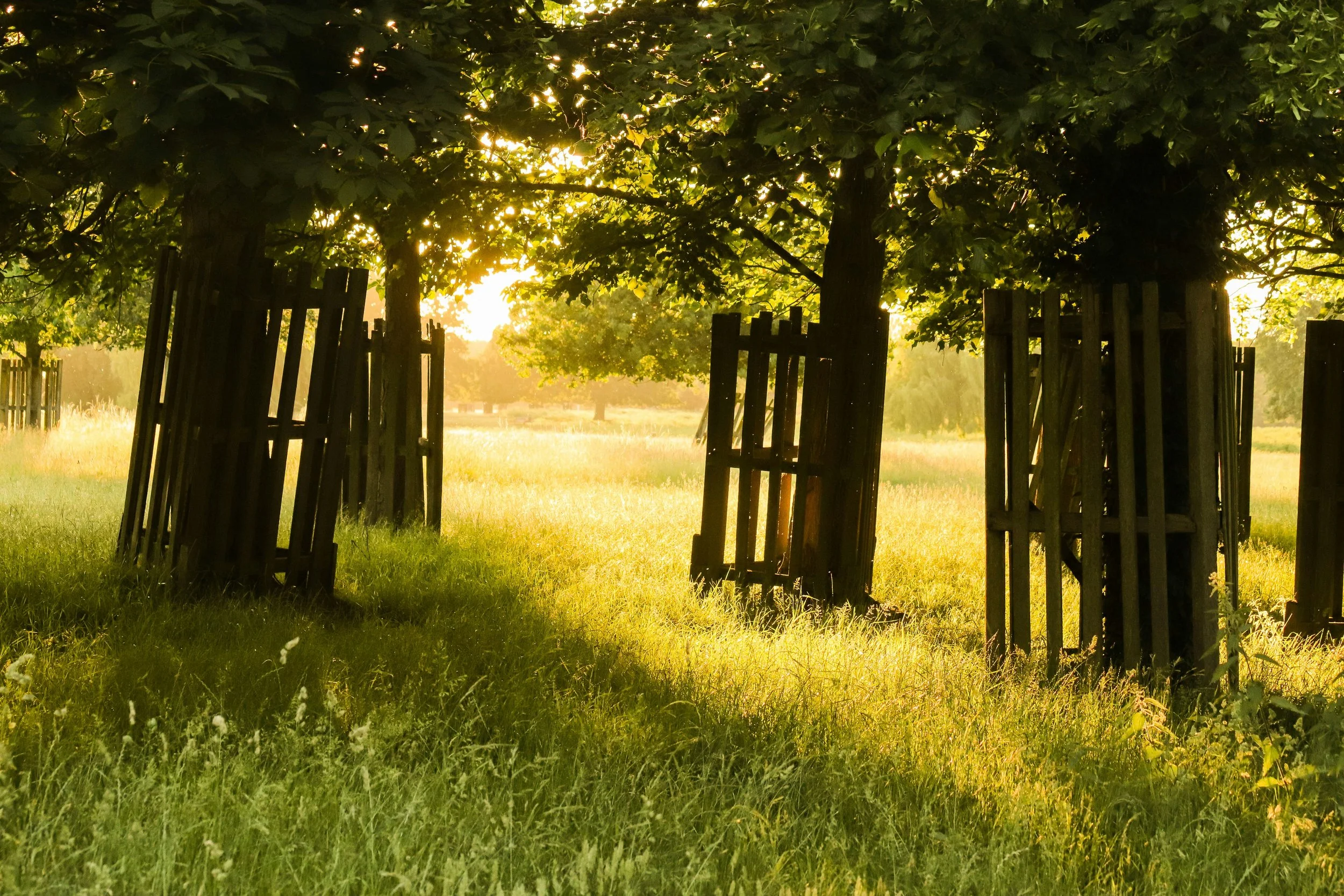Trees secret intelligence: a look at this hidden world
Old tree with thick trunk beside a small stone shrine at golden hour, lit by sunset through dense leaves. Captures the mystery of forest intelligence, rooted wisdom, and the spiritual stillness of ancient trees in a quiet rural landscape.
Listening to the green quiet
You think of a tree as stillness. As silence.
A static fixture rooted in the soil while the world moves on. But linger long enough beneath a tree—really linger—and you may begin to feel otherwise. You may notice that silence is never silent. That stillness hums.
A breeze shivers through a crown of leaves. A root system stretches unseen beneath your feet, searching, reaching, remembering. Insects burrow. Moss thickens. Mycelium threads itself through the loam like neurons in a vast and ancient brain. There is life here. And something else, too—something subtler, more elusive. A kind of mind. A green intelligence that hums just below the register of human senses.
Young trees protected by wooden enclosures stand in golden meadow light at sunset, suggesting a forest’s careful guardianship and the intelligence of natural regeneration.
For centuries, we overlooked this world. Trees were timber. Resources. Shelter. Shade. They stood in our myths, yes—Yggdrasil, the World Tree, supporting the cosmos with its limbs; or the sacred groves of the Druids, in which oak and ash whispered secrets to those who knew how to listen. But in modern times, myth gave way to measurement. Trees became carbon sinks, biofuel stock, data points on a forestry survey. Quiet providers of oxygen and aesthetics. Noble, certainly—but inert.
And yet, that old idea—the one in which the forest speaks—was never truly wrong.
We are beginning to understand, through the precise and patient work of scientists, ecologists, and fungal biologists, that trees do more than live. They perceive. They communicate. They adapt and remember. They problem-solve, strategize, and cooperate. They are not people—not conscious, not sentient in the ways we define those terms—but they are no longer the mute bystanders of life we once assumed them to be.
To walk in the woods now is to walk in the presence of a mystery just beginning to speak.
What is intelligence, when rooted?
We often define intelligence in human terms: the capacity to reason, to solve puzzles, to adapt consciously to new situations. It’s a cerebral affair—neurons firing in gray matter, decisions filtered through cortex and cognition.
But nature works in other languages.
A tree does not think in words. It does not plan its next move in the way a hawk or a dolphin might. But it does sense the world with a quiet acuity. A sapling turns its leaves toward light with precision. A mature tree rations water during drought, tightens its stomata, slows growth in one limb to preserve another. These are responses, yes—but not mindless ones.
Recent studies have revealed a startling array of behaviors once thought exclusive to animals. Trees emit airborne signals when wounded, alerting nearby kin to ramp up their own defenses. They can distinguish between self and other. Their roots, laced with fungal partners in a vast symbiotic network known as the mycorrhizal web, trade carbon, nitrogen, and water with other trees—and sometimes, remarkably, even offer support to weaker neighbors. Some researchers call it the "Wood Wide Web." Others simply call it kinship.
Memory, without a brain
Perhaps the most haunting discovery is that trees remember.
When a sapling survives an early frost, it alters its future response to cold. When a forest endures drought, the collective behavior of its trees changes in the years to follow—an embodied memory of trauma encoded not in neurons, but in proteins, hormones, and gene expression. One Japanese study found that cherry trees remember the length of winter and bloom accordingly, even if moved across the globe. Their cells hold time.
What, then, is memory, if not the capacity to store experience and adjust behavior in the future?
Perhaps the question is not whether trees are intelligent. Perhaps it is whether our definition of intelligence has been too narrow all along.
The forest that talks back
Beneath the leaf-littered hush of a temperate forest, something extraordinary is happening. It is not loud. It is not visible. But it is happening all the same. Just as coral reefs hum with invisible tides and microscopic traffic, the forest hums too—though its voice travels not through sound, but through soil.
This is the hidden world of roots and fungi.
This is the underground parliament of trees.
Each root tip is a sensory organ. Sensitive to water, nutrients, toxins, touch. When roots encounter one another, they pause, they assess. A tree will recognize its own roots, and often those of its kin. Through a symbiotic relationship with thread-like fungi known as mycorrhizae, trees form alliances that span acres. These fungi are neither friend nor foe—but partners in an ancient pact, forged over 400 million years ago.
Through these mycorrhizal networks—some call them fungal highways, others whisper of sentient soil—trees send and receive chemical signals. One emits distress; another receives it and prepares. One falters from drought; another diverts nutrients. There is strategy here. Solidarity. Some scientists, such as Dr. Suzanne Simard, have spent decades tracing these connections—mapping an ecosystem not of isolated individuals, but of a community bound together by threads of cooperation and care.
A person gently touches the leaves of a young tree growing near mature bark, capturing a quiet moment of connection and the intelligence of forest life through human touch.
Imagine it: an old-growth forest, where a dying mother tree slowly feeds her sugars into the roots of her young, giving of herself until her last breath. This is not metaphor. It is measurable. And it is humbling.
Chemical messengers, carried by breeze
Communication in forests isn’t limited to the underground.
In the African savannah, acacia trees emit ethylene gas into the air when grazed by giraffes. Downwind, neighboring acacias “smell” the alarm and begin pumping bitter tannins into their leaves—making themselves less palatable. In this way, danger travels faster than hooves. The forest becomes a place of responsive defense, of swift and silent signal.
Closer to home, oaks and pines release volatile organic compounds when attacked by pests. These airborne messages act as both warning and recruitment—alerting neighboring trees and attracting the predators of the attacker. A sort of ecological diplomacy unfolds: alliances with wasps, deterrents to beetles, chemistry wielded like language.
And all of this happens without a brain. Without intention, at least in the way we mean it. Yet the forest responds. It remembers. It changes.
From competition to collaboration
For decades, the prevailing scientific model of forest life was one of competition. Trees were thought to battle for sunlight, water, and soil, their success a Darwinian duel of fitness. But recent research paints a more nuanced picture—one that honors the individual while revealing the strength of the collective.
In forests with diverse species, cooperation often outweighs conflict. Birch and fir exchange resources seasonally. Deciduous and evergreen trees balance their growth patterns in mutual rhythm. Shade-tolerant saplings wait in the understorey not for their rivals to die, but for the right time to rise.
This is not utopia. The forest still knows death, still prunes the weak and lets rot recycle the fallen. But it also knows generosity. Support. Interdependence.
Golden light filters through tall forest trees, illuminating a lush undergrowth of ferns and wild shrubs, evoking the quiet intelligence of untouched woodland ecosystems.
And in this, perhaps, we see a mirror of what intelligence can be when untethered from ego—when it is embedded in a system, not confined to a skull.
What the forest knows that we forgot
We are the quick ones, we humans.
We race across decades, build empires in the span of saplings. Our minds dart, our fingers twitch. We live in the bright flare of moments, enamored with speed, with noise, with news. But the trees live otherwise.
They dwell in slow time.
Not passive, not inert—but deliberate. They keep counsel with centuries. They speak the grammar of patience, root-syllable by root-syllable. Their growth is measured not in minutes, but in migrations of birds, in meltwaters, in the long curve of the moon. Where we lurch toward future and regret the past, trees remain rooted in a kind of now that expands beyond urgency.
To stand beneath a beech in late autumn, bronze leaves clinging despite frost, is to stand in the company of an ancient attention.
Golden morning mist blankets a dense pine forest, with sunlight casting long tree shadows through the fog in an ethereal aerial view.
The bark bears wounds from storms we don’t remember. Its crown filters light that began its journey through space long before you woke this morning. You are the fleeting one in this exchange.
Trees are not timeless—but they live time differently. They are archives of air and water, of fire and flood. Their rings hold the memory of volcanic winters, of insect plagues, of the long silence after the clear-cut. Each year is a line of testimony: a witness, not just a survivor.
And we forget that they are watching still.
What we learn when we listen
What, then, does this intelligence offer us? What does it mean that the forest thinks—but not as we do? That it speaks—but in chemical whispers and root-touch? That it remembers—and does not forget?
Perhaps it teaches us humility.
That the world is not organized around our scale or our senses.
That consciousness may bloom in forms alien to our own.
And perhaps it teaches us kinship.
For if the tree is not an object, but a presence—
If it feels drought, and sends warning, and feeds its young—
Then we must reconfigure how we walk through the woods. No longer as conquerors. Not even as caretakers. But as kin among kin.
This shift, quiet and profound, is already rippling through science, through art, through culture. Indigenous wisdoms have long known what Western science is just beginning to remember: that plants are not scenery, but society. That intelligence does not require a brain. That the Earth is animate, and we are not its masters but its relatives.
Becoming forest — a way forward
To learn from trees is to unlearn much of what we’ve been taught.
We’ve been told the world is made of objects. That forests are just timber standing still. That nature is a backdrop to human drama. But when you begin to listen to the forest—really listen—you discover something else: the world is composed not of things, but of relationships. Of exchanges and balances. Of voices, most of them quiet. And intelligence, most of it not our own.
Trees live this truth. They are teachers not in words, but in pattern, in stillness, in response. They do not lecture—but they instruct. They do not preach—but they show.
So what does it mean to live in the presence of such wisdom?
Slowing down to the pace of trees
First, it means slowing down.
Much of modern life runs counter to forest time. We rush. We fragment. We multitask. We extract. Trees ask something else of us: presence. A return to rhythms shaped by light, weather, season. A commitment to patience, to the long view. Where we seek results in days, they grow in decades. Where we burn with urgency, they cool the air with stillness.
To walk among trees is to be gently, steadily recalibrated.
And perhaps, if we let that slowness into our bones, we might begin to understand what sustainability really is—not a buzzword, but a mode of being. A humility. A decision to live as if tomorrow matters.
Rewilding our perception
Second, becoming forest means reawakening our senses to a world we’ve been trained not to notice.
The green hush of canopy. The scent of mycelium in damp soil. The flutter of a leaf responding to shadow. The slight lean of a tree away from drought, toward a friend.
This attentiveness is a kind of rewilding—not of landscapes, but of perception. We begin to see more than scenery. We see presence. Agency. Maybe even soul.
And when we see differently, we act differently.
Toward a language of belonging
The old conservation model positioned humans as stewards—wise managers overseeing a passive, dependent nature. But trees challenge that idea. They are not helpless. They are not waiting for rescue. They are already in conversation. Already solving problems. Already nurturing one another. What they need from us is not dominance, but solidarity.
To become forest is to shift from stewardship to kinship.
To understand that forests do not belong to us. We belong to them.
To protect not as benefactors, but as family.
Walking beside, not above
A woman walks gently through tall golden grass during golden hour, surrounded by softly lit trees — evoking a quiet moment of connection with the natural world.
So let us walk among trees not as visitors, not as owners, but as kin.
Let us kneel by roots and ask what it means to live well in a world that thinks and feels and grows in ways we barely comprehend.
Let us remember what the forest has never forgotten:
That intelligence does not reside only in the mind.
That wisdom can take root.
That time is not lost when it moves slowly.
And that we, too, might yet grow into something deeper—
If we are willing to listen.






